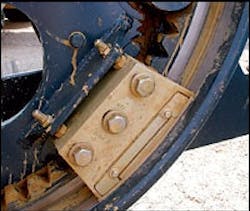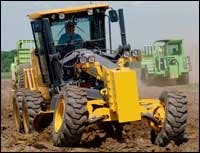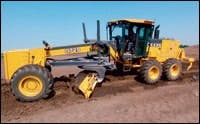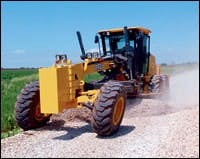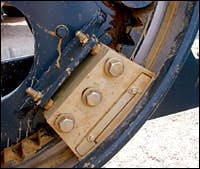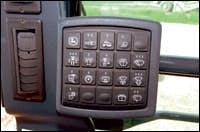Deere's New 872D Pleases Operators
We were impressed by the size of the new John Deere 872D motor grader when it arrived at the site for this installment of Hands-On Earthmoving. The six-wheel-drive 872D and its tandem-drive counterpart, the 870D, are new to the Deere line (introduced as part of the D-Series range earlier this year) and are the largest models Deere has yet offered. The site, by the way, was a 300-acre expanse just south of Joliet, Ill., where Local 150 (International Union of Operating Engineers) is developing a new Apprenticeship and Skill Improvement complex, which you can see in rendering form in this issue's Managers Digest.
On the unseasonably warm day in early June when we caught up with Local 150 instructor/operators Jeff Skinner and Gene Held, they were, in fact, along with their fellow instructors, hard at work at the new site moving dirt with the Local's sizeable fleet of big machines. Skinner and Held took time to run the 872D in a few typical grader applications, then slotted the new machine into the Local's on-site fleet for a couple of days of real work. Since the Local has a Deere 772C motor grader in its fleet, Skinner and Held had a basis for comparison as they offered opinions about the new 872D.
Says Tom Parker, Deere's marketing manager for motor graders, the C-Series graders were great machines, but the new D-series models feature enhancements over their predecessors in four key areas — not counting the Tier-2, emissions-compliant engines in the new machines. Changes include significant redesign of moldboard and draft-frame geometry, new hydraulics, new type of transmission-control system (Event-Based Shifting), and spacious new cab.
Since Held had to road the 872D some three miles to the test site on a hot morning, his first comment was an appreciation for the machine's standard air-conditioning system, which, he said, pushed out plenty of cold air — even with the doors open. He commented favorably, too, on the roominess of the cab and the good forward visibility it affords — "much better than the 772C." But he chose not to use the 872D's cruise-control system, preferring instead "to keep my foot on the pedal and control things that way."
The standard D-Series cab is a "low-profile" configuration, but an optional full-height or "tall" cab is still available. Compared to the C-Series cab, the new standard cab, says Deere, is 26 percent larger, has 40 percent more glass, 64 percent more airflow, and 27 percent more cooling capacity. (Air conditioning was optional on the C-Series.) Although the increased width of the new cab comes at the expense of three degrees of frame articulation (from 25 to 22 degrees), D-Series models, says Parker, still lead the competitive pack with the tightest turning radii.
Our test machine was fitted with a 14-foot moldboard, which is 27 inches tall and 1 inch thick. Changes in moldboard geometry included pushing out the blade's cutting-edge radius and opening up its top radius. According to Parker, these changes cause material entering the blade to begin rolling sooner and to encounter less resistance as it moves up and across the blade. Complementing these changes is a lowered blade-pitch pivot, designed to minimize vertical movement of the moldboard when the operator makes pitch adjustments.
The big change for the draft frame was to raise its front ball-and-socket mounting almost 6 inches to yield a larger throat opening (between the top of the moldboard and the bottom of the circle), thus reducing the potential for material plugging in this area. The higher draft frame also helps keeps the circle level when the operator rotates, says Parker, and makes the circle much simpler to control when making fine-grading adjustments.
To get a feel for the 872D's power and controllability, we asked Held to make a number of V-ditching passes. He chose a large, flat area in which to do this, but cautioned us that the material under foot was a heavy, sticky gumbo that "will push a machine around if you try to take too big a bite."
"When I do a V-ditch," said Held, "I first make a marking pass. I get the toe of the blade out in front of me — right out by the tire. So, if I’m running a stake line, I can look at the tire and know that the blade is cutting right on the mark.”
The only criticism Held voiced about the design of the new Deere grader was, in fact, when setting up for the marking pass. In his opinion, the 872D’s large saddle (the structure on the front frame, just forward of the cab, that anchors the draft-frame-control cylinders) partially obstructed his view to the toe of the blade when positioning for the marking pass.
“There’s a blind spot there,” said Held, “but it’s really not a big deal for me. You can articulate the machine just slightly and eliminate the problem. Otherwise, visibility all around is great.”
After Held did a number of ditching passes, we asked his opinion about the 872D’s performance:
“Overall, I was impressed with its power. You could see that I pretty well had the moldboard loaded up with that sticky material, but it moved right through. The six-wheel-drive makes a big difference, because the front wheels are grabbing, and you’re not trying to push them through the cut.”
(The drive system for the 872D’s front wheels is a dual-path hydrostatic design, and an in-cab control allows the operator to dial in how aggressively the front wheels pull. Also, by adjusting the 872D’s inching-pedal mode, the operator can engage the front wheels simultaneously with the tandem, or can delay engagement until the tandem has taken hold.)
How would you rate the comfort and convenience of the cab and controls?
“The cab is very comfortable and lever placement is good — everything is right there close to you. The levers have a good feel to them and the steering is precise.
“A feature I really like is being able to shift forward and reverse without using the clutch — and without coming to a stop. My initial tendency was to get on the clutch, as you would on other graders, but you get used to the system pretty quickly. Usually when you make directional shifts the transmission is banging, but this is smooth — very smooth.”
(The direct-drive, powershift transmission in the 872D is designed specifically for this machine and uses Deere’s new Event-Based Shifting (EBS) control system. The EBS system electronically senses load and speed parameters, then determines an optimum engagement/disengagement rate for the transmission’s hydraulic clutches. The results, says Deere, are extremely smooth shifts and the ability to make directional changes without using the inching pedal (clutch). The new transmission also provides auto-shift for gears four through eight.)
Pushing stone and muck
Our photographer, George Pfoertner, is a craftsman who works hard at getting the right shot. Just before operator Jeff Skinner was about to use the 872D to spread stone along an old railroad bed that now serves as a temporary access road, George leaned across Jeff’s shoulder to take a couple of shots out the front window of the stopped machine. Upon exiting the cab, George, balancing all of his equipment, unknowingly deployed the machine’s three-shank ripper.
Skinner, unaware that the ripper was down, steadily maintained a large blade load of stone for an eighth of a mile or so, and then the 872D came to an abrupt stop. The sudden realization was that the ripper was down and had apparently snagged an immoveable underground object.
“It’s hard telling what might be buried under there,” said Skinner, “but the machine pulled strongly all the way until we hit something really hard. The blade carries a nice load.”
Skinner then took the 872D onto a wet and rutted haul road that was being used by the Local’s scraper fleet. He made numerous passes along a 400-foot section of the haul road, with the machine slogging through some really tough going.
“The power to the ground seems to be more efficient than with the 772C,” said Skinner. “It didn’t spin the wheels — the engine just lugged down and the machine kept going. You can downshift with the throttle wide-open, and the transmission still shifts really smoothly.”
Was there anything else that you particularly noted about the machine? “The controls are easy to use, and the operator’s compartment is well laid out. In the old John Deere graders, you had the instrument cluster right in your face. And the hydraulics are smooth — much better than the 772C’s.”
(According to Parker, the hydraulic system for the 872D is all new, featuring a pressure-compensated/load-sensing design that gives the feel of having individual control circuits for blade functions. Compared to the C-Series, he says, the new system responds more quickly and allows finer and more consistent adjustment even when multiple functions are engaged. Levers have a light touch, he says, which is consistent between the levers and between the valve banks, whether using a single function or multiple functions.)
When we asked Held to sum up his overall impression of the 872D, he did so succinctly: “It’s a good blade.”
